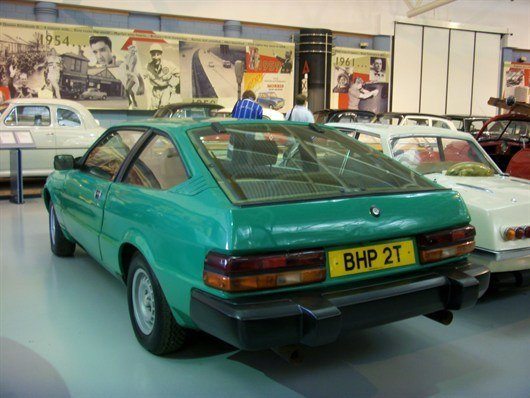Curios: Triumph Lynx

Could this V8 powered four-seater coupe version of the Triumph TR7 have been a sales hit, had it been launched in 1978?
It certainly promised to be a great drive, even if the looks were something of an acquired taste.
The sporting missed opportunity?
The Triumph Lynx's non-production was one of the saddest and most significant missed opportunities posted by British Leyland during the 1970s. For people who have not seen this car before, it might look like a strange Triumph TR7-Rover SD1 remix, but beneath that interesting styling lay a car that had the potential to sell in large numbers - especially in export markets such as the USA.
Unsurprisingly, the Triumph Lynx was born out of the TR7. It was conceived long before the TR7 was launched - and was devised as an up-scale derivative of that car, offering four-seats, and a lift-up hatchback. Because it was obvious that the torquey Rover V8 engine would suit the TR7 range perfectly, it was this engine that would power the Lynx, although eight- and 16-valve versions of the slant-four Dolomite engine were also earmarked for the new sports cars.
The Lynx was straightforward technically, but it offered an intriguing insight to what lay beneath the planned Dolomite-replacing Triumph SD2.
The Lynx's most controversial aspect is probably its styling. And that was done to its gestation - the front was a straight take-off from Harris Mann's TR7, while the rear came from the Solihull design studios - where the Rover SD1 and Triumph SD2 were also in development at the time. The rear end of the car looked vastly different to the donor car and was somewhat unhappy in its detailing – losing the famous Harris Mann plunging belt line in the process. In true 1970s BL fashion, it received deep side scollops, that would end up making their way into the SD1, Maestro and Montego.
In engineering terms, the Lynx was straightforward - combining much thinking from the SD1 and the TR7, and also offering an intriguing insight to what lay beneath the planned Dolomite-replacing Triumph SD2. It was based on the TR7's platform, but had its wheelbase extended by a full 12-inches, while longer passenger doors were incorporated in order to balance the side view of the car and give good access to the rear seats.
Development of the Lynx was stepped up, following commencement of TR7 production in September 1974 and the Lynx was beginning to look like an appealing addition to the range, to fight cars such as the Ford Capri. The gearbox would be the 77mm five-speed unit planned for the TR7 V8 rally car and Rover SD1; the rear suspension would also be shared with the Rover SD1 – a solid rear axle that was well-located thanks to a Watt's linkage and superbly damped. The package looked very viable and once it became clear that the Speke factory in Liverpool would have the excess capacity to produce it, the BL Board gave it the go ahead for production.
The problem was that the time that the tooling was ready to be installed into the Speke factory coincided with industrial relations problems of biblical proportions between the workforce of the Liverpool factory and the company’s management. The turning point for Speke came with the installation of Michael Edwardes at the helm of the company – a man whose task it was to break the Union stranglehold on the company’s factories. At the end of a particularly bitter four-month Strike at Speke, the factory was axed – and with it, the Lynx.

Comments
Compare classic car insurance quotes and buy online. A friendly service offering access to a range of policies and benefits.


 Keith Adams
Keith Adams
 NEC classic motor show 2020 postponed due to Covid 19 concerns
NEC classic motor show 2020 postponed due to Covid 19 concerns
 Classic car auction house Coys goes into administration
Classic car auction house Coys goes into administration
 Motor racing great Sir Stirling Moss dies aged 90
Motor racing great Sir Stirling Moss dies aged 90
 Alfa Romeo anniversary races set for Silverstone
Alfa Romeo anniversary races set for Silverstone
 Government to make E5 fuel available for classic owners
Government to make E5 fuel available for classic owners
 Plans to introduce cleaner fuel could damage more than a million classic cars
Plans to introduce cleaner fuel could damage more than a million classic cars
 Top 10: Classic cars from the Gulf motor racing heritage collection
Top 10: Classic cars from the Gulf motor racing heritage collection











on 8 January 2022
Yep, winner winner chicken dinner!TR7, TR8, Triumph Lynx and Triumph SD2... let's call it the Scorpion...
What a line-up!
Maybe Triumph would still be here today...
Add a comment